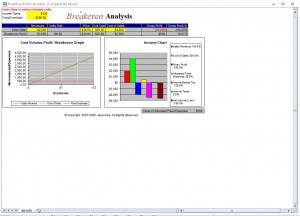
It should come as no surprise that building a business of scratch can be an incredibly flummoxing and labor-intensive process.
Start-ups tend to spawn with brilliant ideas and honest intentions. But without the proper care, maintenance and planning, those well-intended efforts to boost gain a financial foothold streamline revenue can be futile. And more often than not, its the small, seemingly insignificant financial decisions most business owners make in the beginning that can bring down a start-up organization.
However, one tool that start-up business owners and entrepreneurs frequently use to gauge financial success in early years is through a break even analysis. It’s this definitive point to a company’s financial portfolio that helps to define whether or not a business venture was profitable, or costly. In other words, break even points help to express how much money a company needs in order to cover both variable and fixed expenses and a break even point calculator can help you determine these points.
Major Features of the Break Even Point Calculator

With the Break Even Point Calculator from MyExcelTemplates.com, start-up business owners and entrepreneurs can effectively:
- Map revenue and expenses.
- Determine a substantial break even point, based off of timely financial projections. The Break Even Point Calculator contains movable, clear graphs that alternate per the data entries you insert.
- Organize financial projections based off of sales revenue, cost of sales, gross profit, allocated fixed expenses, income before tax, income taxes and net income.
Tips for Making Your Start-Up Business Venture Profitable
- Identify a problem within your customer’s workflow, and navigate a solution to solve it. Honing in on what is relevant to your audience’s preferences and needs is crucial to organizing a profitable business.
- Recycle. As much as you’d like to devise a completely new, innovative product to throw onto a specific market, try not to bite off more than you can chew. Chances are, someone has already formed an outline or branch of the idea. As a start-up business owner, it’s your job to research the ways a specific product can be made better.
- Think in terms of longevity. Although you’re likely to encounter more than a few trendy, alluring niches in your search for the perfect market, try to form a more stable, long-term plan. Will your product be relevant two years from now? What might change market- or technology-wise during that time?
Check out this offer while you wait!

